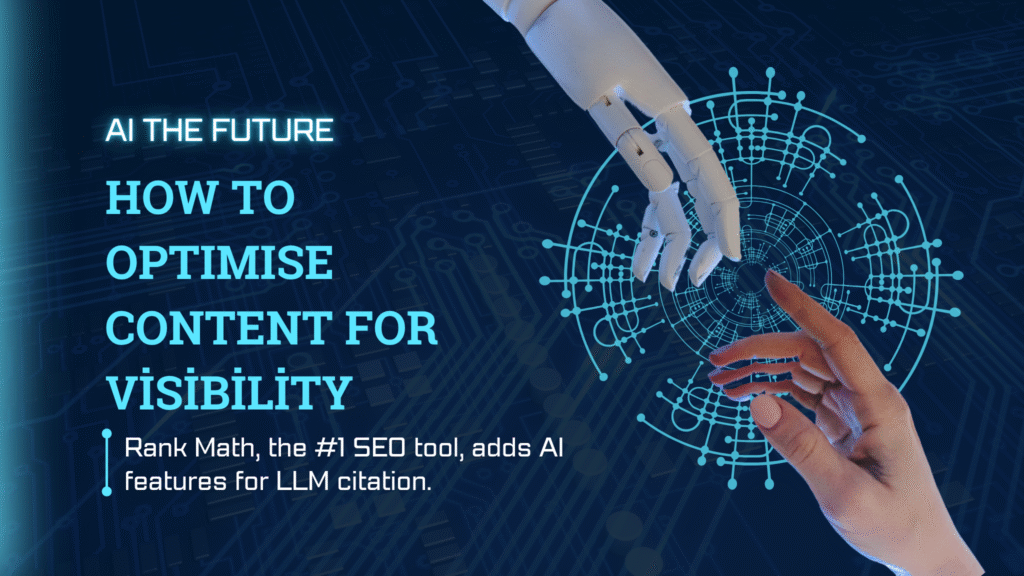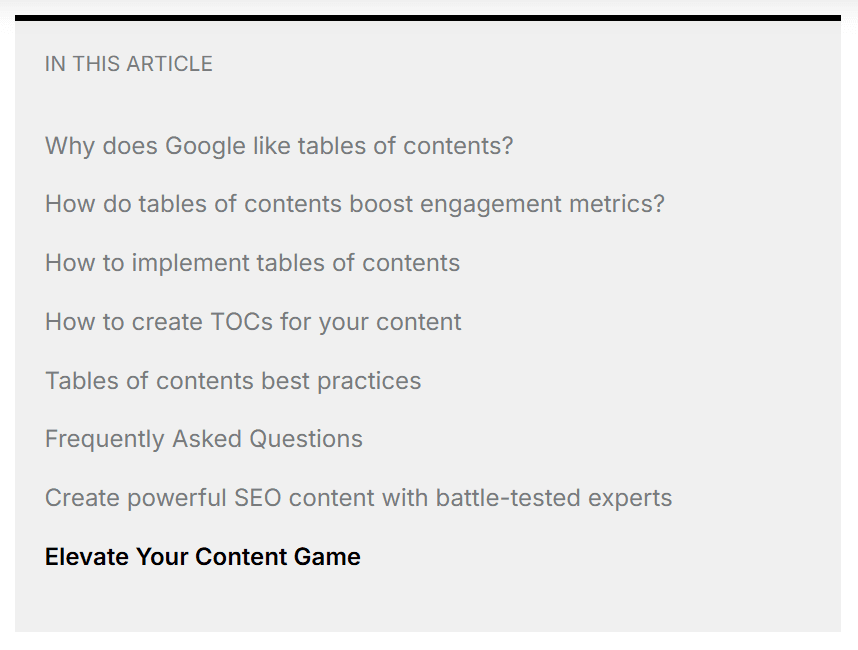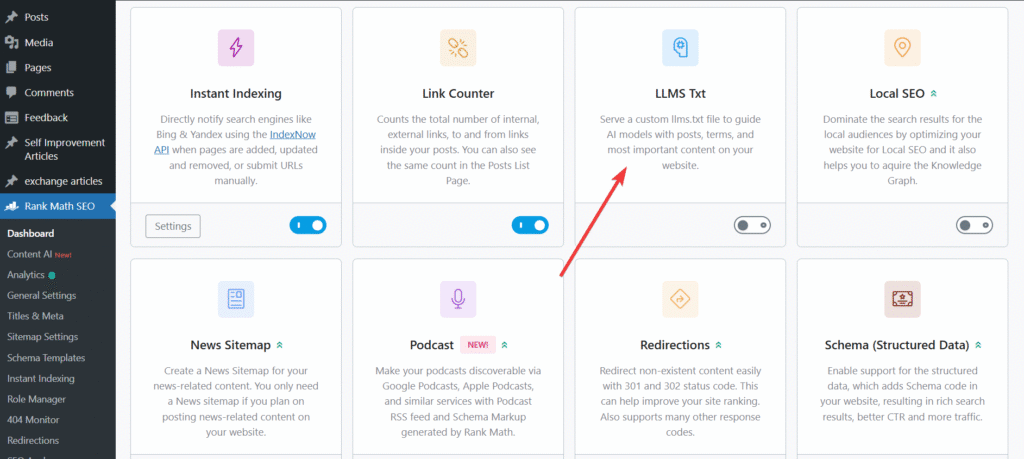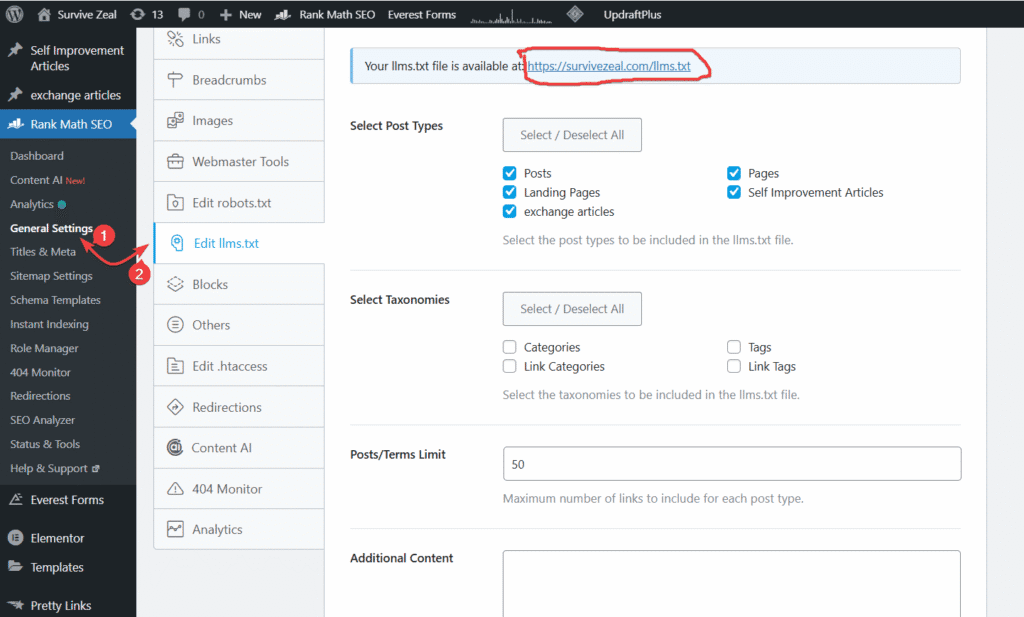How to Optimise your Site for AI Citation and Visibility
The way search engines work is changing fast. What used to be a simple Google search is now powered by AI systems like ChatGPT, Gemini, and Perplexity. These tools read, summarize, and cite web pages to answer people’s questions directly.
This shift means your website is no longer competing for only traditional rankings. You are now also competing for AI visibility — the chance for your content to be cited, summarized, or recommended by AI tools.
Many site owners do not realize that the same SEO foundation that helps you rank on Google is also what allows AI systems to discover and trust your content. But beyond traditional SEO, there are now new strategies such as proper content structure, clean technical setup, and even tools like LLMs.txt that directly tell AI how to read your site.
In this guide, we will look at how to optimize your website for AI citations and visibility, and how Rank Math can help you prepare your content for this new AI-powered search era.

Table of Contents
Why AI Visibility Matters in 2025
Let me tell you why this is very important.
When people search on Google now, they don’t always scroll down to see the 10 links. Instead, they read the AI Overview box at the top. That overview is generated from different websites. If your content is structured well, your site can be picked as a source. If it is not, you will miss out.
It is the same story with AI tools like ChatGPT and Perplexity. These tools are pulling content from different websites, summarizing it, and showing it to their users. They sometimes link back to the source. If your site is included, you get referral traffic.
That is why AI visibility is now part of SEO.
That said, the game doesn’t end just by securing the #1 spot on search. We are now required to consider AI visibility because it’s part of the game.
How to Optimise your Site for AI Citation and Visibility
To optimize your site and content for visibility in LLM citations and AI Overviews on Google, you need to follow a few key principles. The first is the foundation of all good SEO — proper search engine optimization. When your content already ranks within the top 10 results on Google, it has a much higher chance of being referenced in LLM-generated citations and AI summaries.
Beyond that, it’s important to understand how LLMs process and interpret content differently from traditional search. Research from trusted organizations shows that AI models can sometimes overlook certain details, even in well-written, comprehensive pieces. Because of this, your optimization strategy should go beyond standard SEO.
1. Lay the SEO Foundation
Before your website can gain visibility in AI tools, it must first be visible in search engines. Obviously, that’s the starting point.
AI systems like ChatGPT, Gemini, and Perplexity often pull their information from pages already indexed on Google or Bing. So, before thinking about AI citations, make sure your SEO foundation is strong enough.
Rank Math has an in-depth course on Search engine optimization that can help.
1.1 Create Optimized And Intent-Driven Content
Your content must be written strategically around your target keywords but without overdoing it. Keyword stuffing no longer works; what works is relevance.
Write content that matches what the searcher is looking for and provides clear/direct answers. Use supporting elements like:
- Optimized meta titles and descriptions.
- High-quality images with proper alt text.
- Internal links that connect related pages.
- Proper heading hierarchy (H1, H2, H3).
These on-page details help search engines and AI systems understand your topic better. Rank Math makes this easy with built-in analysis, internal link suggestions, and its Content AI tool that helps you target the right keywords naturally.
1.2 Build Citations and Backlinks
In SEO, backlinks are important. In AI optimization, citations matter even more.
AI chatbots tend to quote or mention sites that already have a strong footprint across the web. A “citation” simply means your brand or website name appearing on other trustworthy platforms even without a clickable link.
So, build both:
- Backlinks, to show authority in Google and Bing.
- Citations, to show credibility to AI models like ChatGPT.
If other websites quote or recommend your content, it raises your trust signal. That’s how large language models decide which sources are worth referencing.
1.3 Fix Technical SEO Issues
A strong technical foundation keeps your site accessible to both search engines and AI crawlers.
If your site has errors, broken links, or is blocked by robots.txt, it won’t perform well on either traditional or AI search.
The rule is simple: perform well on Google first, then AI visibility follows.
Here’s what to check:
- Ensure your website loads fast and is mobile-friendly.
- Use HTTPS and proper canonical tags.
- Keep your sitemap updated (Rank Math can handle this automatically).
Don’t block AI crawlers like GPTBot in your robots.txt file because if they can’t access your content, they can’t cite it.
Rank Math helps you detect and fix many of these technical issues directly in your WordPress dashboard.

2. Structure Your Content the Way AI Prefers
AI chatbots like ChatGPT, Gemini, and Perplexity do not read content the same way humans do. They scan through pages quickly, focusing more on structure, clarity, and the parts that are easiest to understand.
Just like the act of skimming, they do not always consume the full article. Sometimes, they skip sections or miss key details if the content.
That is why organizing your content properly is so important. When your article is clearly arranged with good headings, summaries, and short sections, it helps AI bots capture your main ideas faster and to be able to cite it.
2.1 Keep Each Topic Focused
According to research and observation, when large language models query the web, they match pages that talk directly about a specific topic or keyword. AI systems tend to select and cite pages whose titles, headings, and main content all align closely with the search query.
This is different from the traditional SEO practice of combining multiple related topics into one long pillar post. For AI visibility, it’s often better to separate subtopics into their own dedicated pages.
This doesn’t mean you should destroy or “scatter” your existing long content. Instead, treat each subtopic as a standalone page that should go deeper into one angle or use case.
For example, let’s say you already have a broad article on “Best Internal Linking Tools.” That can remain your main hub. But you can also create supporting pages like:
- “Best Internal Linking Plugins for WordPress” — focused entirely on plugins.
- “Best AI-Powered Internal Linking Tools” — focused on tools with AI features.
By doing this, you give AI models more precise content to match when users ask specific questions like “best internal linking plugin for WordPress.”
AI prefers precision. When your page exactly matches the intent behind a query, it’s far more likely to be cited.
Even search engines are showing this trend — focused pages targeting specific intents are performing better than giant all-in-one guides (especially in long-tail keyword search).
So, consider building several smaller, purpose-driven pages. Each can target a unique audience, question, or use case.
2.2. Put the Main Content at the Top
When writing for AI visibility, always put your main content at the top.
Let’s use a list post as an example — say you’re writing “Best AI Affiliate Marketing Tools.” Normally, you’d start with a long explanation about what affiliate marketing is, what AI affiliate marketing means, and how AI can help in the process. That’s fine for human readers, but not ideal for AI discovery.
According to expert research and recent findings, large language models perform better when the core content appears earlier on the page. So instead of starting with long introductions, place the list first. Even a short summary of each item at the top helps AI bots quickly understand your page during their scanning process.
AI models and summarization tools often read the first 20–30% of a page more deeply. If your key content is buried too far down, they may miss it completely.
The closer your main content is to the top, the easier it is for AI systems to identify and cite the right information.
3. Make Your Content Easy to Scan
Large language models don’t read line by line. They scan — just like humans who skim. And when they skim, they can easily skip over important details if your structure is weak.
To help them understand and capture your main ideas:
3.1 Use Clear and Descriptive Headings
Your headings should clearly describe what the section is about. Avoid vague phrases like “More Details” or “Extra Tips.”
Instead, make them self-explanatory and, where possible, include your main keyword naturally.
3.2 Add a Table of Contents (TOC)

A Table of Contents is not just for humans — AI bots also use it to identify the structure of your article.
When AI systems crawl your TOC, they can quickly detect all the key topics covered on your page.
If you’re using Rank Math, you can easily create a TOC optimized for AI visibility. It ensures every important section is outlined in an organized way, improving both user experience and crawler understanding.
3.3 Answer the Main Question First, Then Expand
When writing, answer the primary question early — preferably in the first few lines of a section.
After that, you can go deeper with explanations, examples, or comparisons.
This writing style helps AI systems extract accurate information faster.
It’s better for readers too as they get instant value and stay longer on your page.
3.4 Use TL;DR Summaries for Long Sections
If you have long paragraphs or detailed sections, add a short TL;DR (Too Long; Didn’t Read) summary at the end.
This acts as a mini-outline for AI bots and readers. It highlights your core idea.
3.5 Include a FAQ Section
FAQs are one of the easiest ways to boost AI visibility and win citations.
You can place your FAQ block at the bottom of your post or naturally mix questions inside the content. Either way works or you can do both.
What matters is covering every relevant question users are asking about your topic.
When building FAQ sections, Rank Math’s FAQ block is a great choice. It automatically adds proper FAQ Schema, making your answers machine-readable.

Even though Google reduced how FAQ schema appears in search results, other AI systems still use it to understand your content better. So, it’s still valuable.
4. Integrate the LLMs.txt File
The LLMs.txt file is a new way to control how large language models interact with your website.
Think of it as the opposite of the robots.txt file.
- robots.txt tells crawlers what they can’t access.
- LLMs.txt tells AI models what they should focus on.
You can use this file to guide AI bots to your most important pages, i.e., the ones you want them to prioritize and cite.

How to Set It Up with Rank Math:
Go to Rank Math → Dashboard → LLMS.txt. And toggle the button “ON”.
You can then go to General Settings → Edit lms.txt to customize which URLs you want to highlight.

If your site has fewer than 100 posts, you can simply toggle it on and leave the defaults. But if you have a larger website, it’s better to manually select your key pages such as your cornerstone articles or most referenced posts.
By setting this up, you’re telling AI systems:
“These are my most authoritative pages — quote these first.”
It’s a small step that makes a big difference in how AI models perceive and prioritize your content.
5. Monitor and Analyze AI Traffic
If you want to understand how well your content is performing through AI citations, you need to monitor your AI-driven traffic. Tracking this data helps you see how often your site appears in AI results and how users are finding you through generative AI tools.
5.1 Use Google Analytics to Track AI Referrals
You can use Google Analytics to monitor traffic coming from AI platforms like ChatGPT and Perplexity.
These AI tools usually send referral data whenever they include your link in their responses.
For instance, ChatGPT attaches a referral tag to every URL it cites. When users click that link to visit your site, Analytics records it under referral traffic.
By filtering your reports for sources that contain terms like “chatgpt.com,” or “perplexity.ai,” you can identify exactly how much traffic you’re getting from generative AIs.
This method gives you a practical way to measure your AI visibility in real numbers not just assumptions.
5.2 Use Rank Math Analytics to View AI Search Data

Rank Math SEO has made this process even easier. It now includes a new feature that displays AI Search Traffic directly in your WordPress dashboard.
You can now see how much of your organic traffic is coming from AI search engines like ChatGPT and Google Gemini — right alongside your regular Google and Bing traffic.
The data is presented in a clean graph and helps you measure how your optimization efforts are paying off.
5.3 Keep Measuring and Improving
Monitoring AI traffic isn’t just about checking numbers, it’s about learning what works.
If you notice that certain articles get more visits from AI referrals, study what makes them stand out:
- Are they more structured?
- Do they use better schema?
- Are they mentioned on other websites?
These patterns will guide your future content strategy.
While Rank Math isn’t the only SEO plugin with AI visibility tools, it’s one of the best options available. It gives you everything you need in one place — traditional SEO, Content AI, and now AI Search Analytics.
Consider keeping it active on your site to stay ahead in this new era of AI-driven search.
Conclusion
AI is now part of how people search and how information spreads online. The same way Google changed the way we think about visibility, AI is now changing it again.
If your website is well optimized, structured clearly, and open to AI crawlers, it will not only rank better on search engines but will also start appearing in AI answers and citations.
Tools like Rank Math make this process easier. It helps you build a strong SEO foundation, create structured content, add schema, enable the LLMs.txt file, and even monitor your AI traffic in one place.
This is the right time to prepare your site for AI visibility. The websites that take this step now will lead the new generation of search.
Start optimizing your site today with Rank Math and let your content be among those AI tools love to reference.


